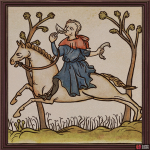Entertainment and Games Society
Text
A medieval nobleman spent his leisure time hunting, playing games, singing, or playing musical instruments. Special diversions included tournaments, dances, or theatre. Books were read very rarely because they were rare, expensive, and most nobles were illiterate.
In the countryside, there were also plenty of opportunities for entertainment, especially because work was strictly forbidden during church holidays and Sundays, which were much more frequent than today. Certain professions could have their work days disrupted by weather or unforeseen events. Typically, people worked around 190 days a year, averaging about 4-5 days a week, but work was not evenly distributed throughout the year. For example, there was much more work around harvest time than in winter.
Among the most popular medieval board games were chess, backgammon, mill (also called nine men’s morris), draughts, hnefatafl, dice, and fox and geese. Of course, ball games were also common. Chess was time-consuming and costly, so it was more popular among the nobility. Backgammon was favoured by townspeople, while the common folk enjoyed simpler games like dice or nine men’s morris. Playing cards and card games appeared in Europe by the late 14th century, but due to limited paper production, they became widespread much later.
Townsmen sought to emulate the nobility in their leisure activities, engaging, for example, in bird shooting. During the 15th century, archery fellowships even began to form in cities.
Gambling games were widespread across medieval society regardless of gender or social status. This is evidenced, for example, by the Maiestas Carolina legal code from December 1350, where ![]() Charles IV himself forbade playing games during Christmas time, and empowered the Archbishop of Prague, Arnošt of Pardubice, to prosecute offenders of any status with fines or spiritual penalties (in extreme cases, excommunication).
Charles IV himself forbade playing games during Christmas time, and empowered the Archbishop of Prague, Arnošt of Pardubice, to prosecute offenders of any status with fines or spiritual penalties (in extreme cases, excommunication).

 Sign up
Sign up
No Comments